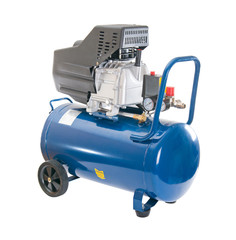The majority of compressors require some form of lubrication to operate efficiently and reliably for extended periods of time. Oil-free compressors, such as those used to supply air for human consumption (where it is absolutely essential that the compressed air must not contain even minute traces of oil) are, however, the exception to the rule. This newsletter deals with the lubrication requirements of the most widespread compressor types that were discussed in OilChat #20.
Reciprocating Piston Compressors
The lubrication requirements of these positive displacement compressors are in many instances the most demanding of all compressor types. Regardless of size and configuration, all reciprocating compressors have similar components to be lubricated. These are pistons, piston rings, cylinder walls, valves, crankcase bearings and cross head components (if fitted). It is particularly important that reciprocating compressor oils should provide adequate protection against wear and deposit formation. The piston ring and cylinder contact area experience all the different lubrication regimes (i.e. boundary, mixed, and hydrodynamic) during every stroke of the piston. Boundary lubrication conditions occur near the top and bottom dead centre when the piston slows down to change direction of travel. This requires some form of anti-wear protection. Exposure of the lubricating oil to hot oxidizing conditions can be severe in reciprocating compressors. Some oil oxidation is inevitable, particularly in the discharge valve area. Adherence of oxidized residues to hot valve surfaces can be minimized by including a stable detergent/dispersant in the lubricating oil. An ideal lubricating oil for reciprocating air compressors would be made from a well-refined stable base oil with ashless anti-wear additives and good high temperature detergents/dispersants, along with oxidation inhibitors, foam suppressants and rust inhibitors for protection during shutdown. Viscosity requirements of reciprocating compressors are in the ISO viscosity range 68 to 220, or even higher for very high pressure, high temperature machines.
Rotary Screw Compressors
These positive displacement compressors use two intermeshing screw-shaped rotors for compression. The two major sub-categories are wet and dry screws. Dry screw designs have timing gears to synchronize the screw movement. However, the most common type of screw compressor is the flooded or wet screw design where the primary (male) rotor drives the secondary (female) rotor. In oil-flooded screw compressors the lubricant is injected into the air being compressed. The oil provides a lubricating and sealing film between the two screws. With these compressors the air and oil must be separated after compression. The major functions of the lubricant are to cool, seal, prevent rust and lubricate the bearings, rotors and shaft seals. In oil-flooded screw compressors there is intimate contact between the air and the lubricant, causing great potential for oxidation and deposits. The lubrication requirements of these compressors are similar to that of reciprocating compressors, except that the anti-wear requirements of screw compressors are not quite as demanding as reciprocating compressors. Viscosity requirements of screw compressors are in the ISO viscosity 32, 46, 68 or 100 range. Oil-flooded screw compressors are the main compressor type used for air compression in industrial applications.
Rotary Vane Compressors
Rotary (sliding) vane compressors consist of a rotor with a number of blades (vanes) in slots in the rotor. The rotor is mounted offset in its housing. Centrifugal forces ensure that the vanes are always in close contact with the housing. These compressors are available in oil-lubricated or oil-less designs. The type depends on the application, duty-cycle, and maintenance preferences. With non-lubricated variants, you replace the vanes with every service. When servicing oil-lubricated rotary vane compressors you replace the oil, filter and maybe the oil separator. Lubrication requirements of oil-lubricated rotary vane compressors are similar to those of oil-flooded (wet) rotary screw compressors. Oil is injected into the air (flooded lubrication) to cool, seal and lubricate the vanes, bearings and endplates. Obviously an oxidation inhibited oil is required. Contact of oil with the air suggests that a foam inhibitor would be beneficial. A rust inhibitor will provide protection against rusting during shutdown and for intermittent operation. In addition, the oil should have good detergent/dispersant properties to maintain a deposit-free circulating system and prevent vane sticking. The vanes may make contact with the cylinder walls in a boundary lubrication condition; therefore anti-wear oils are often used, ranging in viscosity from ISO 46 tol 50, depending on the application.
in more detail in the next issue of OilChat.
Dynamic Compressors
Radial Centrifugal and Axial Flow compressors use very high speed spinning blades or impellers to compress the air. These compressors do not require internal lubrication, hence only rust and oxidation inhibited oils are commonly used to lubricate and cool the outboard bearings. Due to the high speed, relatively low viscosity oils are used. The lubricant generally recommended for dynamic compressors is highly refined rust and oxidation inhibited oil of ISO 32 viscosity grade. Where a gear driven speed increaser is used, an ISO 46 or even ISO 68 viscosity grade may be required.
The same types of compressors that are used for air are also used for gases. Hydrocarbon based lubricants, mineral and synthetic (PAO), should NEVER be used for compressing active gases such as hydrogen, chloride, oxygen, etc. These gases may react chemically with hydrocarbon oils. Under pressure the chemical mixtures of these gases and hydrocarbon oil can be explosive. Lubricants blended with Group V base oils, normally polyalkylene glycol, should be used for gas compressors.
The choice of a compressor lubricant depends on the type and construction of the compressor, the gas being compressed, the degree of compression and the final outlet temperature. Most compressor manufacturers recommend lubricants that have been tested in their machines under controlled conditions. Make sure you are familiar with your manufacturers’ recommended lubricants, keep them in stock and adhere to the specified service intervals. If you don’t, your compressor may end up looking like this….
If you are in doubt our experts are at your disposal and ready to provide you with advice and answer any questions you may have. For more information, call 011 462 1829.

